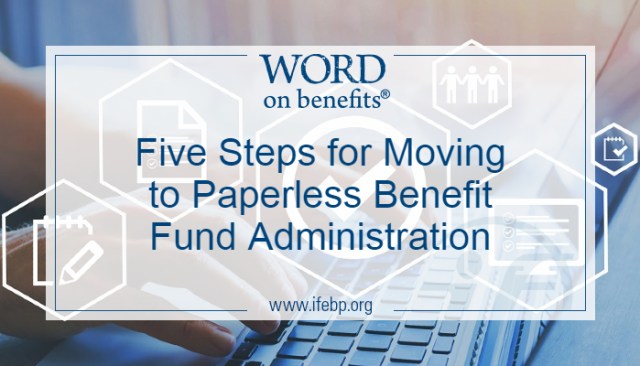
The COVID-19 global pandemic has added urgency to the case for paperless employee benefit fund administration.
In her article “A Virus Makes Paperless Fund Administration Go Viral” in the September issue of Benefits Magazine, Jenny Morgan discusses the advantages and considerations involved in moving to digital benefit operations. Morgan is president and CEO of basys, which provides benefits administration systems for Taft-Hartley third-party administrators and self-administered fund offices.

In the article, Morgan suggests the following five steps that fund administrators should consider when launching paperless administration.
1. Look at where you are today.
Add up the budget for paper, printing and postage. What bottlenecks typically frustrate the team or plan members? Are there major events like annual benefit enrollment or pension plan updates coming up that typically require lots of paper communication with plan participants? How has relying on paper made it more difficult for the team to thrive while working from home?
2. Make the case.
Trustees can see the financial advantages and will appreciate the reduced risk of not requiring employees and members to go into the office. Staff who might previously have resisted giving up their paper files now can appreciate why having access to the information online gives them more flexibility to work from home. Members, retirees and employers will likely get better, faster and more convenient service.
3. Weigh starting with inbound vs. outbound documents.
Outbound: Many organizations begin with paperless outbound communication such as plan disclosures, because that’s where savings in paper, printing and postage are easiest to quantify. Plans should consult with plan counsel as they build the list of documents they want to distribute digitally to ensure they are in compliance with Department of Labor (DOL) regulations.
Inbound: For some plans, starting with inbound communications like pension applications or change-of-address forms makes more sense, especially when staff efficiency and time is a priority.
4. Evaluate tools and technology.
Essentials to starting a digital fund office are secure web portals for members and employers (and maybe trustees) and a cloud-based benefits administration system. To super-charge the paperless process, funds can consider adding automated workflow tools to move documents through your process and an enterprise content management (ECM) system that lets the fund scan, store and retrieve digital documents.
5. Start small and add on incrementally.
Funds don’t have to do it all at once. Funds that already have a website can start by sharing information there instead of via mailings. If they haven’t collected enough participant email addresses to move less sensitive communications to email, they should consider what messages and incentives to include in the paper mailing to collect more. Fund offices going through this transformation successfully learn as they go and adapt their plan as they see what’s working best (or what isn’t).
[Upcoming Webcast: Helping Employees Tap into the Link Between Nutrition and Mental Health | October 27, 2020]
Although moving to a digital-first paperless fund office has many advantages, it’s not without risk or cost, Morgan adds. There can be significant up-front expenses in acquiring the right technology, reorganizing an office, retraining a team and converting reams of critical paper documents into useful digital form, she explains. Funds also may face resistance from staff to making the change, although others will embrace the idea. Funds should consult with fund counsel to review all policies related to the switch to be sure they’re maintaining compliance with the latest DOL guidance.
“Sometimes it takes a crisis to understand the future is now. But even without an urgent crisis, the winds of change are inevitable,” Morgan writes. “More digital innovations are coming to fund offices, and going paperless is the foundation to this vision of the future. For anyone who doubted the urgency of the need for change, the events of 2020 likely have shaken them from complacency.”
![]()
Kathy Bergstrom, CEBS
Senior Editor, Publications at the International Foundation of Employee Benefit Plans
[Related Reading: Tips for Virtual Trust Meetings]
The latest from Word on Benefits:





